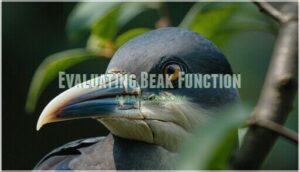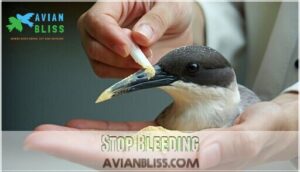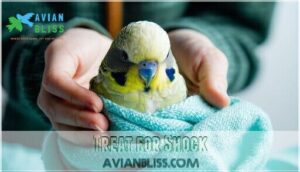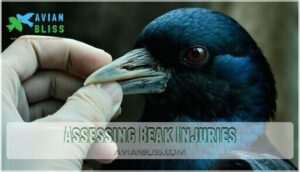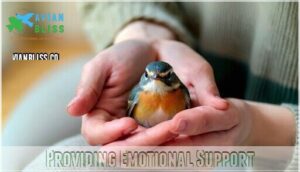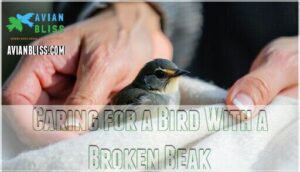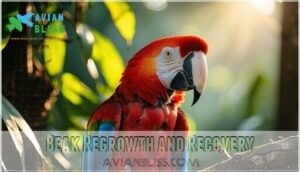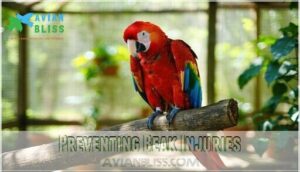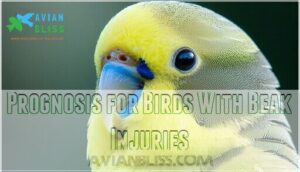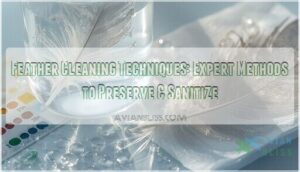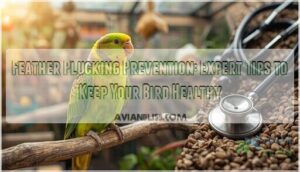This site is supported by our readers. We may earn a commission, at no cost to you, if you purchase through links.
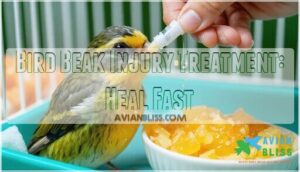
For effective bird beak injury treatment, keep the cage clean, rinse cracks with saline solution, and apply antibiotic ointment if prescribed.
Provide soft foods, ample water, and make certain of proper nutrition.
Your vet may recommend additional steps, such as aligning and gluing broken beak pieces or using Manuka honey for exposed tissue.
By following these steps and consulting your vet, you’ll be well on your way to helping your bird heal – and there’s more to learn about supporting their recovery.
Table Of Contents
- Key Takeaways
- Recognizing Beak Injuries
- First Aid for Broken Beaks
- Assessing Beak Injuries
- Treating Beak Injuries
- Providing Emotional Support
- Caring for a Bird With a Broken Beak
- Beak Regrowth and Recovery
- Preventing Beak Injuries
- Long-Term Care and Rehabilitation
- Prognosis for Birds With Beak Injuries
- Frequently Asked Questions (FAQs)
- How do you treat a bird beak injury?
- How do you treat a broken beak?
- What should a veterinarian do if a bird breaks a beak?
- How do you treat a broken avian beak?
- Can a bird recover from a beak injury?
- How should you feed a bird with a beak injury?
- How long does it take for a bird’s beak to heal?
- Can a bird’s broken beak heal?
- Can birds feel pain in their beaks?
- What to do if a bird has a beak injury?
- Conclusion
Key Takeaways
- You’ll need to act fast when treating a bird beak injury, stopping bleeding, cleaning the area, and providing a soft diet to support your bird’s recovery.
- It’s crucial to create a safe environment for your bird, removing hazards, providing a balanced diet, and ensuring proper hydration to prevent further injury and promote healing.
- You should monitor your bird’s progress closely, watching for signs of infection, malnutrition, and regrowth issues, and adjusting their care accordingly to guarantee a smooth healing process.
- With proper care and attention, a bird’s broken beak can heal, and you can help your feathered friend recover by providing ongoing support, including regular vet visits, a safe space, and a nutritious diet.
Recognizing Beak Injuries
You’ll need to recognize the signs of a beak injury in your bird, which can be a challenging task.
Recognizing beak injuries in birds can be a challenging task
By examining your bird’s beak visually and physically, you can identify potential injuries and take the first steps for effective treatment and care.
Visual Examination
Let’s start by taking a close look at your bird’s beak. A visual examination can reveal a lot!
Look for these signs of bird beak injury or beak abnormalities:
- Notice any color changes or beak discoloration?
- Are there any structural deformities or changes in beak shape?
- Is the beak size normal?
- Assess beak symmetry. Also, check for swelling assessment and lesion identification.
If you spot anything unusual, it’s time to consult your avian vet.
Physical Examination
You’ll examine the beak’s symmetry, using palpation techniques to check for cracks or sensitivity, especially at the bill tip.
This process will help assess the oral cavity and sinus area for any beak injury symptoms or abnormalities.
Ensuring a thorough beak injury assessment is crucial for a complete evaluation.
Evaluating Beak Function
You evaluate beak function by observing daily routines, noting struggles with eating, grooming, or preening, which indicate potential beak injury, affecting prehension ability, manipulation skills, and sensory perception.
Observing changes in behavior can also be key, as reduced activity signals illness, impacting defense mechanisms, nest building, and overall bird beak injury treatment and beak injury assessment.
Identifying Underlying Causes
You’re getting closer to helping your bird.
Consider these underlying causes:
- Nutritional deficiencies
- Infectious diseases
- Congenital defects
- Trauma history
- Environmental factors, to address bird beak injury and beak abnormalities like malnutrition and infections.
First Aid for Broken Beaks
You’re taking the first step in helping your bird recover from a beak injury by learning about first aid.
When your bird’s beak is broken, it’s vital that you stop the bleeding, treat for shock, and provide pain relief to guarantee the best possible outcome.
Stop Bleeding
You’ll apply pressure with a soft cloth to stop bleeding from a bird beak injury.
Hemostatic agents or cauterization methods may be needed.
One should also apply styptic powder to help control the bleeding.
| Method | Description | Effect |
|---|---|---|
| Pressure | Soft cloth | Stops bleeding |
| Hemostatic | Agents | Promotes clotting |
| Cauterization | Heat | Seals wound |
| Clotting | Disorders | Requires veterinary intervention |
| Styptic | Pencil | Aids bleeding control |
Treat for Shock
When a beak injury occurs, shock prevention is critical. Act fast; this is vital for beak injury treatment.
- Warmth provision: Wrap your bird snugly.
- Noise reduction: Keep the environment quiet.
- Calm reassurance: Speak softly to calm your bird.
- Gentle handling: Avoid sudden movements.
- Monitoring signs: Watch for rapid breathing or weakness.
If bleeding persists after applying a clotting agent or styptic pencil, seek immediate veterinary care, folks.
Provide Pain Relief
When treating a bird beak injury, provide pain relief with medication options like meloxicam.
You can find bird meloxicam products online.
| Pain Level | Signs | Pain Relief Options |
|---|---|---|
| Mild | Lethargy | Rest |
| Moderate | Vocalization | Meloxicam |
| Severe | Aggression | Stronger analgesics |
| High | Intense pain | Veterinary guidance |
| Chronic | Long-term pain | Alternative therapies |
The treatment approach depends on the level of pain, ranging from mild to chronic, and the appropriate pain relief options should be chosen accordingly.
Clean and Dry The Beak
After providing pain relief, gently clean the beak with antiseptic solutions.
Then use safe drying methods to prevent infection, monitoring cleanliness closely, a key step in beak injury treatment.
To keep your bird comfortable and promote healing.
Assessing Beak Injuries
You’ll need to assess the beak injury carefully, considering the severity, location, and effect on eating and drinking.
By evaluating these factors, you can determine the best course of treatment and provide the necessary care to help your bird heal quickly and effectively.
Severity of The Injury
When evaluating beak injury severity, consider the fracture type, pain level, and its impact on your bird’s daily routine, as these factors influence treatment guidance and beak injury prognosis.
Including potential complications and recovery time, to determine the best course for healing and rehabilitation from beak fracture.
Location of The Injury
You’re examining the injury, considering the location.
- Upper beak tip issues affect grasping
- Lower beak base damage hinders support
- Mid-beak fractures or base injuries can cause internal damage, sinus involvement, or beak avulsion, affecting the mandible or maxilla.
The examination process involves understanding how different parts of the beak are affected, including the potential for internal damage.
Effect on Eating and Drinking
When your bird’s beak is injured, eating and drinking become challenging.
Offer a soft diet and clever feeding techniques to prevent weight loss and dehydration risks.
Ensuring proper nutritional support for effective bird beak injury treatment.
Potential Complications
You’ll want to watch for infection risks, malnutrition effects, and regrowth issues after a beak injury.
Behavioral changes can also occur, impacting your bird’s overall health and prognosis, including dehydration impact and beak infection complications, such as bleeding and malnutrition.
Treating Beak Injuries
You’re now moving on to treating beak injuries, which requires careful attention to detail and a gentle touch.
By following the right steps, you can help your bird heal quickly and get back to its normal activities.
So to fully understand the treatment options, including aligning and gluing broken beak pieces, using antibiotics, and performing surgery when necessary, is crucial for effective care.
The process involves various methods, but the key is to provide the best possible treatment for a speedy recovery, focusing on gentle care.
Aligning and Gluing Broken Beak Pieces
When fixing a broken beak, use non-toxic adhesive, align pieces carefully, and stabilize with techniques like tea bag patches, ensuring a snug fit to avoid complications and promote successful beak repair and reattachment.
Considering glue toxicity and post-op care is crucial for ideal healing.
You can find a safe beak adhesive online, which is essential for successful beak repair.
Using Manuka Honey or Neosporin for Exposed Tissue
When treating a bird beak injury, consider Honey vs Neosporin for exposed tissue.
- Promote healing
- Prevent infection
- Soothe wounds, use gentle Application Techniques, and monitor effectiveness to confirm proper bird beak injury treatment and wound cleaning.
Many use specialized beak neosporin for this purpose, which can aid in healing.
Providing Antibiotics for Infections
When managing a bird beak infection, you’ll need antibiotics.
Consult your vet for Antibiotic Selection and Dosage Calculation.
Administration Methods vary, so monitor Resistance Monitoring and consider Probiotic Support to prevent further beak infections,
ensuring your bird heals smoothly from the bird beak injury with proper antibiotics.
Performing Surgery for Severe Injuries
You’re facing a tough decision: beak surgery for your bird.
Consider:
- Fracture stabilization
- Anesthesia protocols
- Debridement techniques
Beak prosthetics or reattachment may be necessary.
Post-op care is essential for successful avian beak repair, ensuring your bird recovers from beak surgery or fracture.
Providing Emotional Support
You’ll play a vital role in helping your bird recover from a beak injury by providing emotional support.
Offer gentle care and reassurance to help your bird heal
As you care for your bird, you’ll need to reduce stress and anxiety, creating a safe environment with gentle handling and careful monitoring for signs of distress.
Reducing Stress and Anxiety
You play a key role in reducing stress and anxiety for your bird with a beak injury.
Use calming techniques like soft music, gentle head scratches, and a comfortable environment to provide emotional support, helping alleviate anxiety and promote a sense of safety and belonging.
Creating a Safe Environment
You create a safe space by providing warm, draft-free areas with soft bedding, and secure dishes.
Ensuring gentle lighting, and using bird-proofing homes strategies to prevent beak injury household hazards, is crucial.
This promotes a safe environment for your bird’s recovery.
Gentle Handling and Care
Once you’ve established a safe environment, gentle handling and care become important. When you handle your bird with a beak injury, imagine you’re holding a delicate flower.
Minimizing handling is key, but when necessary:
- Wrap your bird gently in a soft towel.
- Support the body, avoiding pressure on the beak.
- Consider a bird beak protector for extra safety.
- Speak in gentle, reassuring tones to build trust.
Reducing stress is paramount; short sessions prevent exhaustion. Remember, patience is your greatest ally in beak treatment and beak care.
If you’re concerned about your bird’s beak, seek veterinary care from an avian veterinarian. Providing emotional support aids in recovery.
Monitoring for Signs of Distress
Watching your bird closely for bird distress signs is essential after a beak injury.
You’re their best advocate, so spotting changes early can substantially impact their recovery. Vocalization changes, often triggered by stress, are key.
Here’s what to watch for:
- Unusual quietness or excessive vocalization
- Rapid breathing or feather ruffling
- Appetite loss or decreased interest in favorite treats
- Activity reduction or social withdrawal
If you see beak bleeding, beak injury signs, or suspect beak pain, seek bird pain relief from your vet. Remember, a calm bird heals faster!
Caring for a Bird With a Broken Beak
You’re taking the first steps to help your bird recover from a broken beak, and providing proper care is vital.
By following the right techniques, you can minimize stress and prevent further injury, ensuring your bird heals quickly and comfortably.
Providing a Soft Diet
You’ll serve warm, soft foods, mashing fruits or pellets into a paste, to support your bird’s nutritional needs during beak injury recovery.
Ensuring a smooth diet shift with the right food consistency and feeding techniques is crucial.
Offering Small Sips of Water
When caring for a bird with a broken beak, you’ll need to assist with hydration.
- Use a syringe
- Monitor intake
- Check water temperature for ideal hydration techniques and electrolyte balance, ensuring assisted drinking is safe and effective for bird beak injury treatment.
Minimizing Stress and Preventing Further Injury
To minimize stress and prevent further injury, create a safe cage environment by reducing loud noises and bright lights.
Use soft materials on perches and remove toys that could catch on the injured beak, ensuring safe handling and reducing anxiety, thereby preventing trauma for your bird with a beak injury.
Monitoring for Complications
As you nurse your bird back to health, vigilance is key.
Monitor for complications, including:
- Infection signs
- Malnutrition risks
- Regrowth issues
- Behavioral changes
- Pain management, to guarantee a smooth healing process and prevent beak injury complications.
This will help ensure a smooth healing process and prevent potential issues.
Beak Regrowth and Recovery
You’ll be glad to know that beak regrowth is possible with proper care, and this is vital to monitor your bird’s progress closely.
As you care for your bird, you’ll need to adjust its diet, environment, and activities to support the regrowth and recovery process, which can vary depending on the severity of the injury.
Factors Affecting Regrowth
You’ll find that several factors influence bird beak regrowth.
Your bird’s age, nutritional status, and injury severity all play a role.
The location and depth of damage also affect healing time.
Additionally, blood supply and infection control are essential for beak regeneration.
Nutritional impact, particularly a balanced diet, supports the beak injury healing process, promoting healthy beak growth and regeneration.
Signs of Successful Regrowth
You’ll notice fresh keratin growing with a normal color, proper beak alignment, and a smooth surface.
Look for:
- Normal keratin appearance
- Functional improvement
- Improved eating habits
- Positive behavioral changes, indicating successful bird beak regrowth and recovery signs.
Monitoring Progress and Adjusting Care
You’ll track your bird’s beak regrowth journey with regular check-ins.
Monitor healing rate, diet adjustments, and behavioral changes to fine-tune treatment, ensuring a smooth beak injury recovery environment and ideal outcome.
Adjust care based on progress, considering medication review and prosthetic fit, to support beak injury monitoring progress and overall healing factors.
Returning to Normal Activities
As your bird’s beak heals, you’ll reintroduce Activity Introduction, like short flights and Social Interaction, promoting Play Enrichment and Foraging Behavior.
While monitoring Preening Resumption, a key indicator of successful beak injury rehabilitation, and considering beak injury rehoming and socialization challenges.
Preventing Beak Injuries
To prevent beak injuries, you can take simple steps to create a safe environment for your bird, such as covering mirrors and windows, turning off ceiling fans, and providing a balanced diet rich in calcium and vitamins.
By being proactive and taking these precautions, you can substantially reduce the risk of beak injuries and help your feathered friend stay healthy and happy.
Providing a Safe Environment
You’re helping your bird recover from a beak injury. Now, create a secure space with soft, foam-lined perches,
- secure food and water dishes
- gentle lighting
- quiet location
- draft-free area, ensuring a safe environment for beak injury prevention, with supervised flight and hazard removal, using soft perches and gentle lighting for bird safety.
Consider that other birds also need protection from climbing predators, which can be deterred by stovepipe baffle designs.
Avoiding Hazards and Obstacles
Home birdproofing is key to beak injury prevention. You’ve got to remove hidden hazards for a safe environment.
Keep your feathered friend safe from ceiling fans, mirrors, and blinds. Replace rusty cage bars, and check toys.
Here’s how to avoid hazards:
| Hazard | Prevention |
|---|---|
| Sharp Objects | Remove or cover them |
| Open Windows | Close or screen them |
| Toxic Materials Avoidance | Keep away from bird |
| Unstable Perches | Use sturdy perches |
| Window Collision Prevention | Apply decals or film |
Ensuring Proper Nutrition and Hydration
Proper beak nutrition and hydration are critical for your bird’s well-being. Beyond avoiding hazards, guaranteeing the right beak diet is essential. Think of it as your bird’s shield against malnutrition.
- Offer calcium-rich foods, like cuttlebone.
- Serve fresh fruits and veggies daily for essential vitamins.
- Keep water dishes clean and filled with fresh water.
- Include protein-rich foods to support beak strength.
- Supplementing vitamins can help.
Consider soft food options if your bird has difficulty eating. Proper beak feeding and hydration methods are important. Monitor weight to guarantee your bird is getting enough.
Long-Term Care and Rehabilitation
You’ll need to provide a suitable environment for your bird’s recovery, which includes a safe space and a balanced diet.
As you care for your bird, you’ll gradually introduce normal activities, ensuring a successful recovery and rehabilitation process.
Providing a Suitable Environment for Recovery
For long-term bird recovery, you’ll want to create a safe enclosure.
Keep the temperature between 75-85°F.
A spacious cage, about twice the normal size, is ideal.
Include soft perches at different heights.
Create cloth-covered corners for hiding.
This comfortable bird environment should be in a quiet area for reduced stress.
Supporting native plants and trees can further enrich the environment.
Monitored interaction and gradual reintroduction will aid bird health after bird injuries.
| Feature | Benefit |
|---|---|
| Warmth | Promotes healing |
| Spacious Cage | Prevents further injury |
| Soft Perches | Comfortable footing |
| Quiet Location | Reduces stress, aids bird care |
Gradually Introducing Normal Activities
As your bird’s beak heals, reintroduce normal activities gradually.
Start with gentle preening sessions to build confidence, increasing supervised cage time.
Reintroduce short flight exercises in safe spaces, allowing social interactions slowly.
Consider Perch Introduction, Toy Reintroduction, and Diet Modification to support rehabilitation and behavioral training, providing emotional support for birds during activity reintroduction after a beak injury.
Ensuring Successful Release or Rehoming
You’re preparing a bird with a healed beak injury for release or rehoming, considering release criteria and rehoming challenges.
Develop an adaptation strategy, evaluating flight skills, feeding ability, and social skills, to guarantee successful release or rehoming.
Provide post-release monitoring and ongoing support.
Providing Ongoing Support and Care
For beak injury ongoing support, you’ll need regular vet visits. You got this!
- Track weight weekly for Nutritional Support.
- Document eating habits, and behaviors daily for Behavioral Monitoring.
- Adjust their space for Environmental Enrichment, like soft perches.
Remember, patience is essential for beak injury emotional support and beak injury stress reduction. Gentle handling and Medication Management are key. Physical Therapy helps too! Keep an eye out for beak injury anxiety management.
Prognosis for Birds With Beak Injuries
You’re likely wondering what the prognosis is for your bird’s beak injury, and to better understand the situation, consider the factors that affect recovery.
By considering the severity of the injury, potential complications, and expected recovery time, you can better care for your bird and help it heal quickly and effectively.
Factors Affecting Prognosis
Consider your bird’s age, overall health, and injury severity when evaluating prognosis.
| Factor | Description | Impact |
|---|---|---|
| Age | Young or old | Recovery speed |
| Health | Underlying conditions | Complications |
| Injury | Severity and location | Recovery time |
Potential Complications and Risks
You’ll face several risks, including infection, beak deformities, and regrowth problems.
Infection risk is high, especially with exposed tissue, and malnutrition effects can worsen complications, while dehydration risk and behavioral changes may also occur, complicating the healing process.
Expected Recovery Time and Outcome
You’ll see your bird recover from a beak injury within 4-8 weeks.
Proper diagnosis and treatment are essential for a successful recovery.
The recovery timeline varies, affecting functional outcomes and quality of life.
Factors like nutrition impact the beak healing process and prognosis factors, influencing recovery time and beak injury outcome.
Long-Term Effects and Considerations
For birds that have been through a beak injury, there may be some longterm impacts on their lives. You might notice some regrowth challenges, but don’t worry, many adapt well.
Here’s what you should keep in mind:
- Regular check-ups to watch for beak complications.
- Dietary adjustments and modified feeding stations.
- Social support to lessen beak behavioral changes.
Think about prosthetic care and how it improves their quality of life. They’re resilient!
Frequently Asked Questions (FAQs)
How do you treat a bird beak injury?
Treating a bird beak injury is like solving a puzzle, you’ll need to stop bleeding, clean the area, and provide a soft diet.
While seeking veterinary care for proper assessment and guidance is crucial, it is essential to take initial steps to address the injury.
How do you treat a broken beak?
You’ll need to clean, stabilize, and possibly glue the broken beak, then provide a soft diet and monitor healing, seeking veterinary care for severe or complicated breaks immediately.
What should a veterinarian do if a bird breaks a beak?
You’ll likely rush your feathered friend to a vet, who’ll assess the break, provide pain relief, and possibly perform surgery to repair or reconstruct the beak.
How do you treat a broken avian beak?
You’ll clean and dry the beak, stop bleeding, and provide pain relief, then seek veterinary care for proper assessment and treatment to repair the broken avian beak effectively.
Can a bird recover from a beak injury?
You can help a bird recover from a beak injury with proper care, including veterinary attention, a soft diet, and a safe environment to reduce stress and promote healing.
How should you feed a bird with a beak injury?
You’ll feed a bird with a beak injury softly, offering easy-to-eat foods like mashed veggies, fruits, or cooked eggs to reduce strain on their sensitive beak.
How long does it take for a bird’s beak to heal?
You’ll find beak healing times vary, but generally, it takes a few weeks to several months for a bird’s beak to fully heal, depending on the injury’s severity.
Can a bird’s broken beak heal?
Like a delicate flower, a bird’s broken beak can heal with proper care, you’ll need to provide a safe environment and veterinary guidance to support the recovery process.
Can birds feel pain in their beaks?
You should know that birds can feel pain in their beaks due to nerve endings, particularly near the tip, which provide sensitivity to temperature and pressure, affecting their overall well-being.
What to do if a bird has a beak injury?
When the chips are down, you’ll want to stop bleeding, clean the beak, and seek vet care to help your bird heal from a beak injury quickly.
Conclusion
Healing is within reach, you’re now equipped to tackle bird beak injury treatment, helping your feathered friend recover swiftly.
By following these steps, you’ll be supporting their journey to wellness, and with the right care, your bird will be back to its normal self, making bird beak injury treatment a successful process for you.



